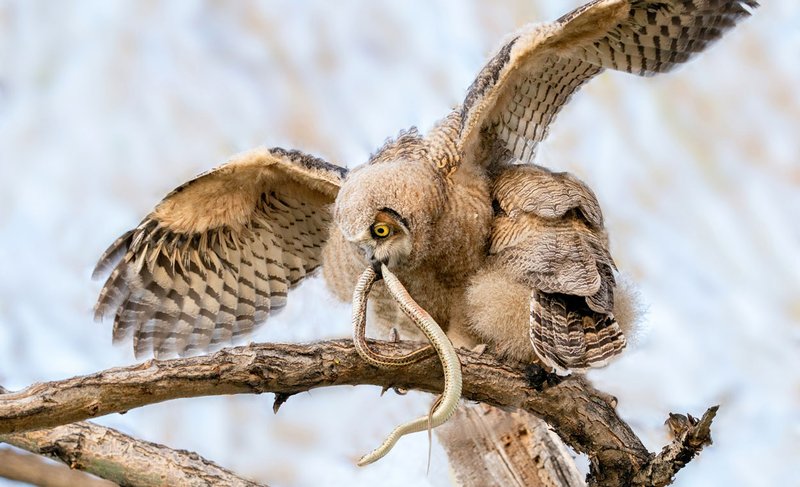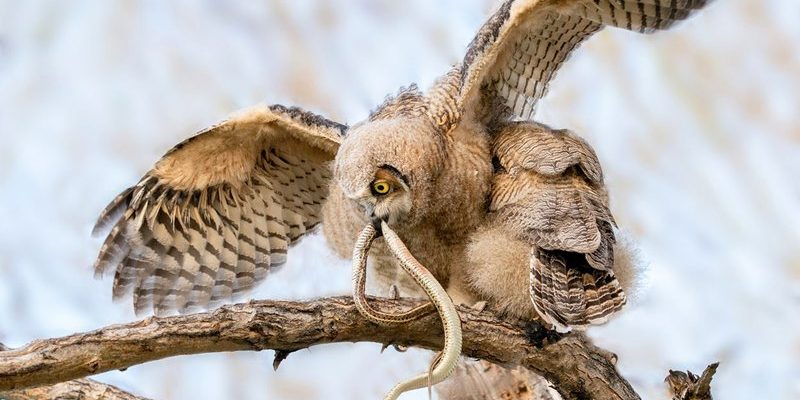
What makes their eating habits so interesting is the way they hunt. Think of it like a game of stealth and strategy. They have unique adaptations that help them stalk and capture prey effectively. It’s like watching a skilled athlete in action, combining patience, speed, and precision. In this article, we’ll explore what the Great Horned Owl eats and how it goes about its hunting or foraging.
Diet of the Great Horned Owl
The Great Horned Owl has a diverse diet, allowing it to thrive in various environments. They’re known as opportunistic feeders, which means they’ll eat whatever is available. This can include:
- Rodents: Mice and voles make up a significant portion of their diet.
- Rabbits: These fluffy creatures are just the right size for a hungry owl.
- Birds: They’ll hunt smaller birds, including sparrows and even larger birds like ducks.
- Insects: During certain times of the year, insects can be a staple food source.
- Reptiles and Amphibians: Occasionally, they may snack on snakes or frogs.
What’s fun about their diet is that it can vary depending on where they live. For instance, in urban areas, you might find them feasting on pigeons. In contrast, in rural settings, they’re more likely to target small mammals. So, if you’re in a park and spot a Great Horned Owl, you’re witnessing a master at work, choosing its next meal based on the buffet of options it sees around it.
Hunting Techniques of the Great Horned Owl
Now let’s get to the good part: how do they actually catch all this food? The Great Horned Owl has several impressive techniques in its arsenal. Think of it as having a Swiss Army knife of hunting skills. They rely heavily on their senses, especially their exceptional hearing and night vision.
One of the most fascinating aspects of their hunting is their ability to silently swoop down on prey. Their feathers are specially designed to muffle sound, allowing them to glide almost silently. This stealth mode helps them get close to unsuspecting prey without raising alarm. Imagine sneaking up on a snack without making a peep—pretty impressive, right?
Additionally, they often use a strategy called “perch and pounce.” They’ll sit on a high perch, like a tree branch, scanning the ground below for movement. Once they spot a potential meal, they’ll swoop down with impressive speed and accuracy. It’s a bit like watching a sniper in action, focused and precise.
Learning About Prey Behavior
Understanding the behavior of their prey is crucial for the Great Horned Owl’s hunting success. For example, they know that certain small animals are more active at twilight or during the night. This knowledge helps them time their hunting trips perfectly.
They also pay attention to how their prey reacts to sounds. For instance, when a mouse hears a noise, it might freeze, thinking it’s safe. This is when the owl takes its chance! Their ability to adapt their hunting strategies based on the behavior of their prey is a classic example of nature’s cleverness.
Let me explain a little more: if you think about it, hunting isn’t just about brute strength. It’s about intelligence and keen observation. The Great Horned Owl demonstrates this perfectly. They don’t just rely on their physical tools; they think strategically about when and how to hunt.
Seasonal Changes in Diet
As the seasons change, so does the Great Horned Owl’s menu. During winter, when food is scarce, they may have to rely on larger prey. They are not picky eaters, and they adapt their diet based on what’s available. This flexibility is vital for their survival.
In spring and summer, the availability of small mammals and young birds increases. That’s the prime time for the owls to hunt since many animals are busy reproducing, leading to a higher chance of catching young and inexperienced prey.
You might be wondering how they manage to find food during harsh winter months. They often have to cover larger territories in search of meals, showcasing their resourcefulness. This adaptability is key to their success in different environments, ensuring they always have something to eat, regardless of the season.
Feeding Habits and Digestion
After a successful hunt, the Great Horned Owl doesn’t just dive straight into the feast. They have unique feeding habits that set them apart. First, they often tear their prey apart before consuming it, using their strong beaks to rip flesh from bone. This can be quite the sight!
Interestingly, they don’t digest everything. The parts they can’t break down, like bones and fur, are later regurgitated in the form of pellets. These pellets can provide valuable insights into their diet and health. Bird watchers and researchers often collect these pellets to study what the owls are eating.
So, if you ever come across a little “owl pellet” on a nature walk, it’s like finding a treasure map of the owl’s meals. It helps to reveal crucial information about their hunting habits and the ecosystem around them.
The Great Horned Owl is a remarkable predator, showcasing incredible skills in hunting and foraging. Their varied diet, stealthy hunting techniques, and adaptability make them one of the most fascinating birds in the natural world. Understanding what they eat and how they hunt not only enriches our knowledge of these beautiful creatures but also highlights the delicate balance of nature.
So, next time you’re in the great outdoors and hear that unforgettable “who,” remember—the Great Horned Owl isn’t just hooting around. They’re on the prowl, mastering nature’s game of survival, one meal at a time. Whether they’re catching a mouse or a rabbit, these owls are a testament to the beauty and complexity of the wild. Happy birdwatching!

